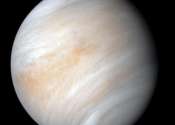New analysis shows how sulfur clouds can form in Venus' atmosphere
Scientists using sophisticated computational chemistry techniques have identified a new pathway for how sulfur particles can form in the atmosphere of Venus. These results may help to understand the long sought-after identity ...









